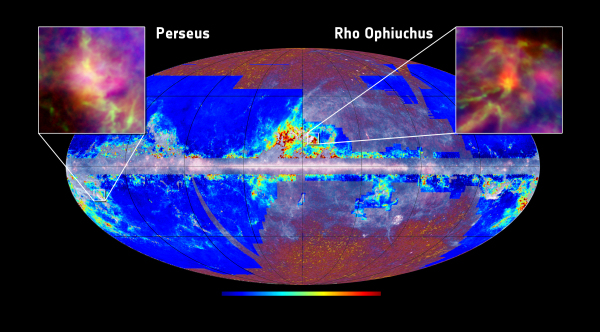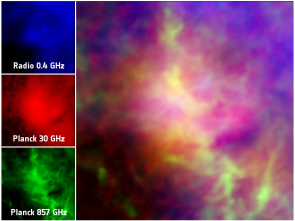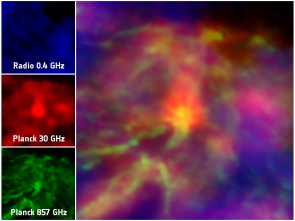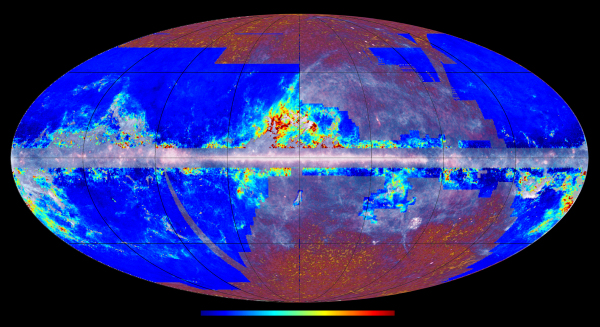Planck sees new, mysterious components in Milky Way and Magellanic Clouds
11 January 2011
Thanks to its broad spectral coverage and very high sensitivity, Planck is peering deep into the interstellar medium of the Milky Way and discovering new components and physical mechanisms taking place therein. The results emerging from Planck's first all-sky survey include strong evidence for the presence of extremely rapidly spinning dust grains, an excess emission explained in terms of a previously poorly quantified 'dark gas' and the characterisation of an excess emission arising from the interstellar medium that permeates the Small Magellanic Cloud, a nearby galaxy orbiting our own Milky Way. These are amongst the highlights presented by the Planck Collaboration at a conference held from 10 to 14 January 2011 in Paris, France.The interstellar medium (ISM), the mixture of gas and dust that permeates the Milky Way, plays a crucial role in regulating the life cycle of stars in the Galaxy. Although the general picture of its composition and dynamics is fairly well understood, many details are still poorly known. While performing its all-sky observations in the microwave and submillimetre regions of the electromagnetic spectrum, targeting the first light emitted in cosmic history, Planck's detectors also absorb substantial amounts of radiation emitted by the ISM: albeit a nuisance for cosmologists, these data represent a rich reservoir of information for all astrophysicists studying the dust and gas that fill our Galaxy.
The dust component in the ISM is known to shine brightly at far infrared and submillimetre wavelengths, but it is not expected to emit at the longest radio wavelengths. Surprisingly, in the 1990s a significant emission, coming from dust-dominated regions of the Milky Way, was detected in the microwave band of radio waves—this was dubbed the Anomalous Microwave Emission (AME). Several theoretical mechanisms have been developed since then to try and explain this mysterious emission and now, thanks to the broad spectral range of Planck and the excellent quality data collected during its first all-sky survey, astronomers are finally able to shed some light on this highly debated topic.
"We are now becoming rather confident that the emission is due to nano-scale spinning grains of dust, which rotate up to ten thousand million times per second," says Clive Dickinson from the University of Manchester, who led an analysis of the AME using Planck's maps. "These are the smallest dust grains known, comprising only 10 to 50 atoms; spun up by collisions with atoms or photons, they emit radiation at frequencies between 10 and 60 GHz," he explains.
The investigation focussed on two, very well studied regions of star formation in the Milky Way, the Perseus and the Rho Ophiuchus molecular clouds. Thanks to Planck's high sensitivity and to its unprecedented spectral coverage, it has been possible to characterise the anomalous emission arising from these two objects in such great detail that many of the alternative theories could be discarded, and to show that at least a significant contribution to the AME, if not the only one, is due to nano-scale spinning dust grains.
The mechanism of spinning dust has also been invoked, in another study, to explain an anomalous emission detected in the Small Magellanic Cloud, one of our two, closest galactic neighbours. "Both Magellanic Clouds are known to exhibit an excess of radiation in the submillimetre range," explains Jean-Philippe Bernard from the Institut de Recherche en Astrophysique et Planétologie (IRAP) in Toulouse, France, who led an analysis of the Magellanic Clouds based on Planck data. "In the case of the Large Magellanic Cloud, we have demonstrated that this excess is due to the cosmic microwave background fluctuations, whereas, for the Small Magellanic Cloud, we have confirmed the previously recorded excess emission. The excess radiation can be explained in terms of a combination of emission from spinning dust grains and from large, amorphous dust grains," he adds.
Planck's first all-sky survey has also allowed astronomers to detect and for the first time quantify accurately on large scales another peculiar component of the ISM which had remained elusive thus far. Apparent as an excess of dust emission, sometimes referred to as 'dark gas', this component is thought to be composed of molecular gas which remained largely unnoticed because it contains too little carbon monoxide (CO), the molecule employed by astronomers to trace the presence and to measure the amount of molecular hydrogen (H2) in the interstellar medium. "We believe that this 'dark gas' may be associated with the periphery of dense molecular clouds, where energetic ultraviolet photons destroy the CO molecules but leave the H2 undisturbed," notes Bernard, who led also the study revealing this previously poorly quantified constituent of the ISM.
These results highlight the ability of Planck to measure the temperature and the column density of gas in the ISM with such a high accuracy that it has been possible to uncover the presence of components in the ISM which have previously been suspected but not confirmed. "By literally revealing to us what has only been guessed at before, Planck is enabling us to probe new components and physical processes in the ISM, in the process shedding new light on the complex mixture that regulates the evolution of the Milky Way and other galaxies," concludes Jan Tauber, ESA's Planck Project Scientist.
Notes for editors
ESA's Planck mission maps the sky in nine frequencies using two state-of-the-art instruments, designed to produce high-sensitivity, multi-frequency measurements of the diffuse sky radiation: the High Frequency Instrument (HFI) includes the frequency bands 100 – 857 GHz, and the Low Frequency Instrument (LFI) includes the frequency bands 30-70 GHz.
The Planck Early Release Compact Source Catalogue (ERCSC) and the first scientific results to emerge from this mission are being presented this week (10-14 January 2011) at the conference "The Millimeter and Submillimeter Sky in the Planck Mission Era" held in Paris, France.
The Planck Scientific Collaboration consists of all the scientists who have contributed to the development of the Planck mission, and who participate in the scientific exploitation of the Planck data during the proprietary period, which nominally ends with the release of the scientific products to the community 3.5 yr after launch, i.e. in January 2013. These scientists are members of one or more of four consortia: the LFI Consortium, the HFI Consortium, the DK-Planck Consortium, and ESA's Planck Science Office.
Related publications
Planck Collaboration 2011, "Planck Early Results: Origin of the submm excess dust emission in the Magellanic Clouds", submitted to Astronomy & Astrophysics
Planck Collaboration 2011, "Planck Early Results: All sky temperature and dust optical depth from Planck and IRAS: Constraints on the "dark gas" in our galaxy", submitted to Astronomy & Astrophysics
Planck Collaboration 2011,"Early Planck Results: New Light on Anomalous Microwave Emission from Spinning Dust Grains", submitted to Astronomy & Astrophysics
Contacts
Clive Dickinson
Jodrell Bank Centre for Astrophysics
University of Manchester
Manchester, UK
Email: Clive.Dickinson manchester.ac.uk
manchester.ac.uk
Phone: +44 (0)161 275 4232
Jean-Philippe Bernard
Institut de Recherche en Astrophysique et Planétologie (IRAP)
Toulouse, France
Email: Jean-Philippe.Bernard cesr.fr
cesr.fr
Phone: +33 5 61 55 75 38
Jan Tauber
ESA Planck Project Scientist
Directorate of Science & Robotic Exploration
ESA, The Netherlands
Email: jtauber rssd.esa.int
rssd.esa.int
Phone: +31 71 565 5342








